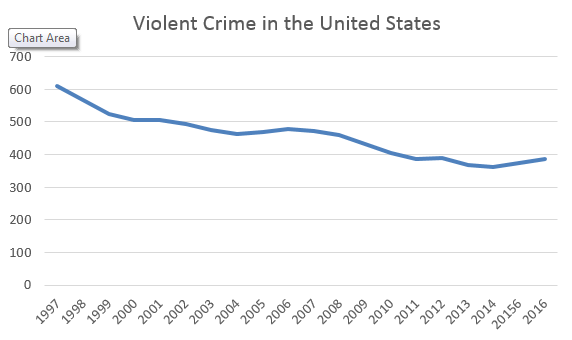I have conflicting views, and I find that troubling. It’s not the first time it’s happened, and it certainly won’t be the last time it happens. My conflict has to do with crime rates and mass incarceration. I am against mass incarceration, but I like low crime rates, and, because the two are correlated, it makes me worry about a cause and effect relationship. Let’s delve deeper.
First things first, a bit of a rant. Correlation is an amazingly powerful mathematical function. It gets dumped on all the time: “Correlation is not causation” as if causation is the gold standard, and correlation, therefore, falls short. This is bullshit. While it’s true that correlation does not necessarily mean causation, it’s not the fault of the statistic itself, it’s a function of how it can be used. If I perform a carefully controlled experiment in the lab, for instance, testing the effect of the hormone angiotensin II on the drinking response in rats, I will find a very strong correlation between giving angiotensin II and the amount of drinking behavior given. In that case, the correlation is showing causation. If I measure the number of churches in a town, I will likely find that it correlates with the number of bars in the same town. This does not show causation, but it’s not the weakness of the correlation itself, it’s a weakness of the question I asked. It’s actually a STRENGTH of the correlation itself that it can tell me anything at all when there is no experimental design. That’s not a weakness, that’s flexibility, and correlation is a hell of a lot more flexible than something like a t-test or an ANOVA. So stop dumping on correlation and start praising it for being so amazingly versatile that it can give us information when the other statistics fail.
I feel better now, so lets talk about my cognitive dissonance to get things back in balance. Crime rates are down. I made the graph below from FBI data found here. It shows a decline in violent crime from 1997 to 2016. The values given are the number of violent crimes in a given year per 100,000 people, so a value of 600 means six violent crimes for every thousand people in the country. Violent crime, in this case, means murder, rape, robbery, and aggravated assault. Details aside, the data show that crime rates are down since the mid-late 1990s.

There are some nuances here, and things that some have pointed to when discussing this, and I would be remiss to ignore those things here. For instance, although the latest numbers put us at a violent crime rate around 4 violent crimes for every 1,000 people, and although this is much lower than the peak of almost 8 per 1,000 that we saw in the early 1990s, our current numbers are not as low as the roughly 1.5 violent crimes per 1,000 in 1960. So, our current rates are less than our peak, but not as low as our bottom. On the other hand, our murder rates are, actually lower than the low rates we saw in the early 1960s (these numbers are from a FactCheck.org article you can find here). This does not mean that crime is down everywhere, and that’s a key element in the FactCheck article. Crime rates are up in some cities, and down in others, but overall the average is a decrease in violent crime rates from the peaks we’ve seen in earlier years.
Lower crime feels like a good thing to me, and something that should be applauded. But here’s the flip. According to data compiled by the ACLU (and others), more than 2.2 million Americans are behind bars (this is a combination of federal, local, and state prisons and jails). The United States is about 5% of the world’s population, while holding 25% of the world’s inmates. An NAACP fact sheet states that the number of people incarcerated rose from about 500,000 to more than 2.2 million in a span of 35 years, and the ACLU (and others) estimates the cost of this to be more than $80 billion per year. Moreover, there is awful racial disparity in incarceration rates. , and, maybe more important for some of us, this is an issue of race, and drugs, and drugs and race. According to the NAACP fact sheet linked to above, the rate of incarceration for African Americans is five times that of whites. Many of these are for drug crimes, were we see that 12.5% of illicit drug users in the United States are African American, but African Americans represent 29% of those arrested for drugs, and 33% of those incarcerated for drugs. Something is wrong, and I feel very strongly that it’s our job to fix it.
But here’s where the conflict lies. In the same period that violent crimes decline, mass incarceration increases. Indeed, we do not have an experimental design that can show causation, so we’re left using our powerful and flexible correlation, but the correlation is there, nevertheless. As incarceration rates increased, violent crime rates decreased. What then, will happen to violent crime rates if we purposefully decrease incarceration rates?
I do not know the answer to this, and I’m more than certain that crime rates are a function of much more than incarceration, but it’s hard to not wonder if locking up lots of people helped reduce crime rates. So I stand conflicted, wanting both low crime and a reduction in incarceration rates, which might increase crime. Maybe this will be resolved some day…

And maybe hell will freeze over.
LikeLike
Before we end mass incarceration? Yeah, probably.
LikeLike